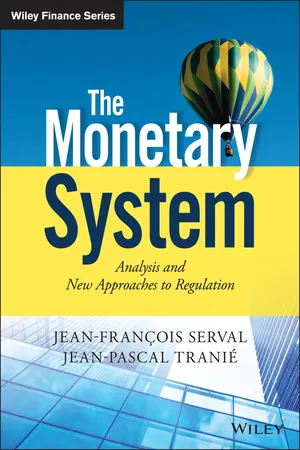
The Monetary System
Analysis and New Approaches to Regulation
- English
- ePUB (mobile friendly)
- Available on iOS & Android
The Monetary System
Analysis and New Approaches to Regulation
About This Book
A groundbreaking work that paves the way for a new, pro-active financial system
With The Monetary System, innovative author pairing Jean-Francois Serval and Jean-Pascal Tranie devise a comprehensive economic modeling system that accounts for the unprecedented situation facing international and regional economies by developing a controversial new stance on the operation of money in society. Presenting a classification of financial instruments with a view toward their underlying legal structures, the book sheds new light on the present economic and financial problems of slow growth and rising debts, and proposes possible outcomes for the global economy.
The authors have already gained international attention with their novel approach to currency, and now they turn their attention to the social function of money in all its myriad forms. The book provides a way forward in an era of increased life expectancy and other new social patterns and the social role of money provides a framework for understanding intergenerational redistribution—an urgently pressing task in our time.
- New aggregate financial categories and economic modeling reveal a possible foundation for increased financial stability
- Companion website includes key mathematical models, accounting standards, and PowerPoint slides
- Comprehensive theoretical underpinning presents the contemporary model of money as a social contract
- Insights into the current economic situation make sense of sovereign debt risk in markets around the world
With questions and answers at the end of each chapter, The Monetary System will help you form a new conception of the role of money in society. Improved regulation and tax policies are needed to stabilize the global economy, and this book provides the framework for getting there.
Frequently asked questions
CHAPTER 1
From Antiquity to Modern Times; Monetary Development Over 5000 Years. What History Explains and Comparison within New Contexts
“We are used to setting a company either for our entire assets or for a specified business purpose: such as the buying and selling of slaves. There was a dispute over whether a company could be set in order to have one of the participants granted a bigger part of the profit and less of the losses; Quintus Mucius considered this to be against the mere nature of a partnership while Servius Sulpicius, whose decision prevailed, considered that a partnership could be set in order to have one of the partners not participate in the losses while sharing in the profits subject to the fact that his personal contribution was precious enough to make such provision equitable”1— Gaïus, Institutes, III, pp. 148–154
THE ORIGIN OF MONEY; FROM ANTIQUITY TO MODERN TIMES
A Metallic System Allowing Intrinsic Measurement Stamping: Ingots to Coinage
Grounding the Guarantees of Stamping: From an All-Metallic System to Paper Bills
Table of contents
- Cover
- Series
- Titlepage
- Copyright
- Acknowledgements
- Foreword and Introduction
- CHAPTER 1 From Antiquity to Modern Times; Monetary Development Over 5000 Years. What History Explains and Comparison within New Contexts
- CHAPTER 2 Modern Times – Liberation and Growth of the Money Supply. The Facts Presented in Monetary Units and Resulting Regulatory Needs
- CHAPTER 3 Past and 21st-Century Money Analysis
- CHAPTER 4 The Contemporary Basis for Money Expression: Accounting Ledgers
- CHAPTER 5 The Regulation and Observation Limits Already Accepted, Compared with the Realities of Modern Exchanges
- CHAPTER 6 Redefining the Monetary System and Measurements of Monetary Flow – Towards M5 and M6
- CHAPTER 7 The Monetary System
- CHAPTER 8 What is the Conceptual Essence of Contractual Money, Constraints and Implications?
- CHAPTER 9 The New Nature of Money in Electronic Times
- Conclusion
- Glossary
- References
- Selected Articles
- List of Monetary Central Institutions and Others (International and National) with Websites
- Index
- End User License Agreement